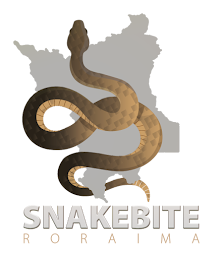
WHO WE ARE:
The SNAKEBITE RORAIMA group seeks to promote an educational program in relation to snakebites in the state of Roraima, in order to generate educational and training actions regarding snakebite with different approaches and complexity, working from health professionals to lay people. Our actions are carried out by UFRR professors and students, in addition to national and international collaborators. The group is supported by UFRR, FEMARH, SESAU-RR, and is funded by the Hamish Ogston Foundation. This project corroborates with the new strategy of the World Health Organization (WHO), which seeks to reduce 50% of snakebite accidents till 2030.
Roraima: the state with the highest incidence of snake envenoming
Ofidism is classified as NTD (Neglected Tropical Disease) being responsible for more than 130,000 deaths worldwide each year. Ophidism is an envenoming situation resulting from the bite of a venomous snake. Unfortunately, a significant part of the population is still unaware about the snakebite reality, which causes a number of deaths higher than the sum of all other NTDs combined.
 Roraima also suffers from this problem in a serious way, because it is the Brazilian state with the highest rate of snakebite in Brazil, with almost 100 envenomings by snakes per 100,000 inhabitants. For comparison, in the State of Amazonas, 45 envenomings by snakes occur per 100,000 inhabitants. Several factors contribute to this rate of the state of Roraima and among them is the fact that a large part of the state is indigenous territory, presenting a considerable vegetation area, which increases the chance to encounter snakes. However, the absence of strategic actions by government makes it difficult to improve the scenario. The lack of investments in the health system, which does not provide enough antivenoms or adequate training for health professionals, and the lack of prevention campaigns contribute to the snakebites growth in Roraima.
Roraima also suffers from this problem in a serious way, because it is the Brazilian state with the highest rate of snakebite in Brazil, with almost 100 envenomings by snakes per 100,000 inhabitants. For comparison, in the State of Amazonas, 45 envenomings by snakes occur per 100,000 inhabitants. Several factors contribute to this rate of the state of Roraima and among them is the fact that a large part of the state is indigenous territory, presenting a considerable vegetation area, which increases the chance to encounter snakes. However, the absence of strategic actions by government makes it difficult to improve the scenario. The lack of investments in the health system, which does not provide enough antivenoms or adequate training for health professionals, and the lack of prevention campaigns contribute to the snakebites growth in Roraima.

Do you know what is a Neglected Tropical Disease ?
Tropical Neglect Diseases (NTDs) are a group of diseases that commonly occur in developing countries and are responsible for high morbidity and mortality. Currently there is a list of 20 NTDs according to the World Health Organization (WHO) and approximately 1 billion people are affected, especially the poorest and most disadvantaged.
List of Neglected Diseases (WHO)
- Buruli ulcer
- Mycetom
- Chromoblastomycosis
- Chagas disease
- Onchocerciasis
- Dengue and Chikungunya
- Rabies
- Dracunculiasis (guinea-worm disease)*
- Scabies
- Echinococcosis
- Schistosomiasis
- Foodborne trematodiases
- Soil-transmitted helminthiases
- Human African trypanosomiasis (sleeping sickness) *
- Snakebite envenoming
- Leishmaniasis
- Taeniasis/Cysticercosis
- Hansen's disease (leprosy)
- Trachoma
- Lymphatic filariasis
- Yaws
*Diseases not presented in Brazil.
Brazil has more 18 from the 20 NTDs listed by WHO, some of which are Dengue, Chagas Disease, Leishmaniasis, Lymphatic Filariasis (Elephantiasis), Leprosy, Schistosomiasis, and Ophidism.WHO has set the goal of decreasing 50% or even ending NTDs by 2030, but the unfavorable record imposes the need for actions between different areas such as science, health, technology, infrastructure, and education to be able to have better diagnostic methods, more effective prophylaxis practices, and raising awareness among the population to be able to achieve the goal of eradicating these diseases and saving lives.
The Snakebite Roraima Program have 4 main objectives
1. Develop a Snakebite Training Program (STP), which will enrich clinical knowledge regarding snakebite envenomings enabling the healthcare professionals and students to identify the snake genus responsible for the accident and, consequently, indicate the best treatment (e.g. specific antivenom) for the victim. The STP has also the objective to reduce side effects (i.e. Anaphylaxis and Serum sickness), since it will decrease the use of polyvalent antivenoms (for more than one snake genus) and, consequently, the unnecessary use of high antivenom doses, resulting in an improvement of victims’ prognosis. Thus, the STP will allow a better treatment for snakebite victims;
2. Develop a Snakebite Prevention and Control Program (SPCP) to disseminate snakebite information for different communities: rural population, indigenous, military community (army), and Venezuelan migrants. Thus, SPCP will empower and engage communities towards prevention, control and, consequently, it might reduce the number of snakebites in the state;
2. Develop a Snakebite Prevention and Control Program (SPCP) to disseminate snakebite information for different communities: rural population, indigenous, military community (army), and Venezuelan migrants. Thus, SPCP will empower and engage communities towards prevention, control and, consequently, it might reduce the number of snakebites in the state;
3. Education of medical students, who will be responsible to disseminate the snakebite knowledge in both programs (STP and SPCP);

4. Produce snakebite illustrated material to promote the control, prevention, and prehospital support of snakebites in different languages (Portuguese, Spanish, and Yanomami), which will be used during the programs (STP and SPCP). The informative material will be available to download in the project homepage as well as will be shared in social media (Project`s Facebook profile).










